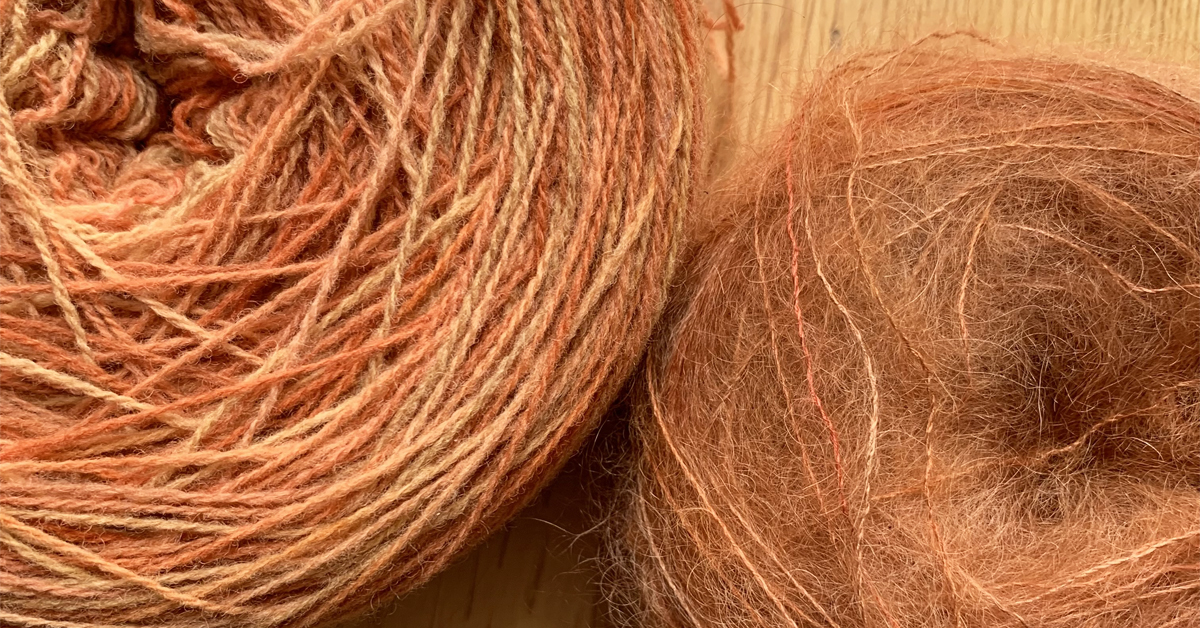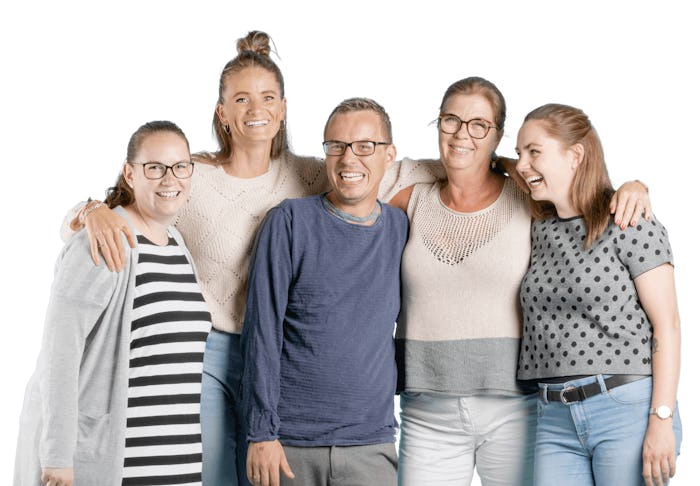Have you ever wanted to dye your own yarn? You can do so easily - with solar dyeing! All it takes is a few simple items, some sunshine, and a little bit of patience.

Solar dyeing is a method where you use the sun as a heat source to bind color to the yarn. Instead of standing over a pot of hot water, you can let the yarn and dyestuff sit in the sun for a couple of weeks to dye it. You get the colors from natural materials, meaning any natural material you can find in nature - plants, flowers, fruits, vegetables 🍏
The process is slower but yields beautiful results. And there’s something very special about being able to create colors with natural ingredients and seeing water and yarn slowly change color 🌈
I’ve tried solar dyeing myself, and I’m completely hooked. My first solar dyeing project has given me yarns in the most beautiful shades of light brown, and I can’t wait to use them 🤎
What you need:
A large mason jar
It’s important that there’s enough room for the yarn and all the ingredients. If everything is cramped in there, the color won’t be able to distribute properly and will become more concentrated in certain areas. Both scenarios are fine, there’s no right or wrong way to do this. I used a 5-liter/1.3 gallon mason jar myself.
Dyestuff
This is where you can really let your imagination run wild. You can go for a walk in nature and gather flowers, leaves, plants, berries, etc. 🍓 You can also do a deep dive in your fridge for fruits and greens like red cabbage, onion peels, and whatever else you might be able to find 🧅 Ingredients like coffee, tea leaves, and beans can also create beautiful colors ☕ If your stores are a little empty and nature’s too far away, then you can choose to buy your raw materials online. You can typically find several interesting ingredients in online health food stores.
Basically, you can use anything that has a color. But you should know that the yarn may not end up the same color as the original ingredient. For example, avocado pits and peels may result in pink yarn 🥑
One important note! The colors you can achieve with natural ingredients will usually be limited to colors you can find in nature. Many ingredients will often create shades of yellow, brown, green, and red. And it’s almost impossible to guarantee certain shades. Although, certain plant and wood species can yield exciting results, like Logwood or Bluewood which can give bluish-purple colors 💙
Solar dyeing is a natural process, so there’s a level of trial and error. But it’s also a little exciting not to know what the final result will look like.
TIP: It’s incredibly difficult to recreate a color to get matching skeins with solar dyeing. So, remember to color plenty of yarn in the same or several jars to make sure that you have enough yarn for your knitting/crochet project 🧶
Yarn
Once again, you have plenty of options here. Natural fibers like cotton, wool, bamboo, and silk work best since they absorb color easily 🐑 Synthetic fibers like acrylic and polyester don’t absorb color nearly as well.
If you choose yarn made from 100% synthetic fibers, you run the risk that it won’t absorb a lot of color. That’s why I’d recommend that you choose yarns made from at least 50% natural fibers.
Remember, the original color of the yarn is also affected by solar dyeing. For example, I’ve used heather on a yarn with a natural color, which resulted in yellow color. But if you use heather on gray yarn, you’ll get a greenish color instead.
Binding agent
To ensure that the colors bind themselves to the yarn and won’t rinse off in the wash, you need to use binding agents like alum. You can buy alum in most large grocery stores. You need approx. 0.7 oz (20 g) of alum per 3.5 oz (100 g) of yarn.
Sunshine
Solar dyeing got its name for a reason - you need sun! However, it doesn’t mean that you can’t succeed if you have a couple of days with no sunshine, but the jar needs to be warmed up in the process.
So, make sure to put the jar where it can soak up the most sun and heat, like in a greenhouse, the sunny corner of your garden, or on the windowsill. The jar typically needs to be left in the sun for 3 weeks - mine has been soaking up the sun outside for 3 weeks.

How to:
When you’ve gathered all your ingredients, it’s time to get started!
First, you need to prepare the yarn. To ensure that the color can reach all of the yarn, the yarn needs to be in hanks. You can make your life a lot easier by buying yarns that are already in hanks. At Hobbii you can get yarn like Unicorn Solid in the color Cream (01), which is already in the form of a hank.
Alternatively, you can make a hank yourself by wrapping the yarn around the back of a chair or a yarn swift. To make sure that the yarn doesn’t tangle and create knots, you should tie short pieces of string or yarn around the hank in several places. To make life easier, you can tie a long piece of string around the yarn to easily remove it from the jar when the coloring process is done.
Now you need to soak the yarn to make sure it’s soaked all the way through before you put it in the jar. While the yarn is soaking, you can prepare the alum mixture by putting it in a container or bowl full of hot water to let it dissolve. You need to stir it until you can’t see the alum anymore 👀
Then add your materials to the jar. Start by placing one end of your yarn hank in the bottom of the jar. Then add some of the dyestuffs and fold the hank in half over it to get more yarn into the jar. Add a little more dyestuff to the jar and finish by placing the rest of your hank and any leftover dyestuff. That way, the yarn and dyestuff are layered so that every piece of yarn is in contact with the dyestuff. You decide how you want to mix the materials and how much you want to add to the jar. That way, you can really experiment with the coloring process.

You could also put some of the dyestuffs up against the glass of the jar - it makes the whole waiting process even more fun since you can see the beautiful materials better and watch how the color spreads ✨
As the last step, add the alum mixture to the jar and top it off with lukewarm water until everything is covered and the liquid reaches the neck of the jar.
Now, close the glass and put it in its designated spot where it can soak up some sun. Over the next couple of weeks, you just need to check up on the process and open the jar once in a while because the process may cause a slight fermentation and create pressure in the jar.
It’s important that the yarn is always covered by water. If some of the water evaporates, you need to top it off with some more lukewarm water.

TIP: It can get a little messy when you pack your solar dyeing jar and when you reopen it, so it’s a good idea to do it outside or in the bathroom.
After 3 weeks in the sun, all you have to do is take out the yarn, rinse it in a bucket of water and try to get the dyestuff out of the yarn.
If you’re having a hard time getting all the dyestuff out of the yarn, you can let it dry first. I dried my yarn by hanging it over a broomstick in the shade. When it was dry, I could shake out most of the leftover material.

Remember, you need to be careful since the yarn may get tangled in the process.
As the final step, I put the yarn in a washing bag and washed it on a wool setting with some wool detergent before hanging it up to dry again. It’s important that you let the yarn dry completely before you wind it to make sure that it doesn’t rot.
Voila - beautiful, sun-dyed yarn 🤩
You can see the results of my first attempt at solar dyeing here 👇 I used lambswool and silk mohair yarns. Both yarns were dyed with crushed walnuts and rose madder - the lambswool also got a bunch of heather in the mixture 🌿

My latest solar dyeing batch is made with Unicorn Solid in every jar. One is colored with heater, which has resulted in the most magnificent yellow color, and the other, once again, with walnut and rose madder. You can see the results below 👇

I already have several projects in mind and have bought some lavender, crushed hibiscus, crushed milk thistle, marigold, and goldenrods. I wonder what colors will appear?
Warm sunshine greetings,
Mette



Leave a comment